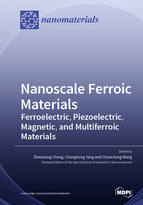Nanoscale Ferroic Materials—Ferroelectric, Piezoelectric, Magnetic, and Multiferroic Materials
A special issue of Nanomaterials (ISSN 2079-4991). This special issue belongs to the section "Nanocomposite Materials".
Deadline for manuscript submissions: closed (31 July 2022) | Viewed by 28952
Special Issue Editors
Interests: condensed matter physics; theory and design of materials; ferroelectric/dielectric/piezoelecitric/multiferroic materials and their applications, nanomaterials
Interests: piezoelectric and ferroelectric materials, including composition design, preparation, electric properties, and their applications in sensors/transducers
Interests: dielectrics; ferroelectrics; physics; materials and their applications
Special Issues, Collections and Topics in MDPI journals
Special Issue Information
Dear Colleagues,
Ferroic materials, including ferroelectric, dielectric, piezoelectric, magnetic, and multiferroic materials, have broad applications in current modern society. Based on their rich physics and the related properties, ferroic materials can have applications for different purposes. For example, based on the switching of domain, ferroelectric and magnetic materials can be used for information storage. Based on the piezoelectric property, piezoelectric materials can be used as sensor/actuator/energy harvesters. Based on the coupling of magnetic order and ferroelectric order, multiferroic materials can have applications as magnetic field sensors and for information storage with the advantages of high storage density and low power consumption. Recently, nanoferroic materials have found new applications based on their ferroic property (low dimension limited size effect) and high surface area—for example, catalysis for water splitting, organics degradation, and CO2 reduction.
Obviously, ferroic materials have shown their great advantages in terms of applications in modern society and are going to find more novel applications in the future. This Special Issue on “Nanoscale Ferroelectric, Piezoelectric, and Multiferroic Materials” aims at collecting the most recent advances on nanoscale ferroic materials and their novel applications in different fields of interest. For this reason, this Special Issue will include a large variety of materials and related applications, such as ferroic nanostructures and materials, including ferroelectric, dielectric, piezoelectric, magnetic, and multiferroic nanomaterials (oxide materials, two-dimensional materials, alloys), their applications in energy harvesting, sensing, catalysis, information storage, etc. Papers on a fundamental understanding of the novel properties demonstrated by nanoscale ferroic materials are also welcome.
The submission of regular articles and review papers on the above electronic materials and related devices is welcome.
Prof. Dr. Zhenxiang ChengProf. Dr. Changhong Yang
Prof. Dr. Chunchang Wang
Guest Editors
Manuscript Submission Information
Manuscripts should be submitted online at www.mdpi.com by registering and logging in to this website. Once you are registered, click here to go to the submission form. Manuscripts can be submitted until the deadline. All submissions that pass pre-check are peer-reviewed. Accepted papers will be published continuously in the journal (as soon as accepted) and will be listed together on the special issue website. Research articles, review articles as well as short communications are invited. For planned papers, a title and short abstract (about 100 words) can be sent to the Editorial Office for announcement on this website.
Submitted manuscripts should not have been published previously, nor be under consideration for publication elsewhere (except conference proceedings papers). All manuscripts are thoroughly refereed through a single-blind peer-review process. A guide for authors and other relevant information for submission of manuscripts is available on the Instructions for Authors page. Nanomaterials is an international peer-reviewed open access semimonthly journal published by MDPI.
Please visit the Instructions for Authors page before submitting a manuscript. The Article Processing Charge (APC) for publication in this open access journal is 2900 CHF (Swiss Francs). Submitted papers should be well formatted and use good English. Authors may use MDPI's English editing service prior to publication or during author revisions.
Keywords
- Dielectric film
- Energy storage
- Multiferroics
- Ferroelectrics
- Piezoelectrics
- Energy harvesting and storage
- Piezoelectric and ferroelectric catalysts
- Sensors









